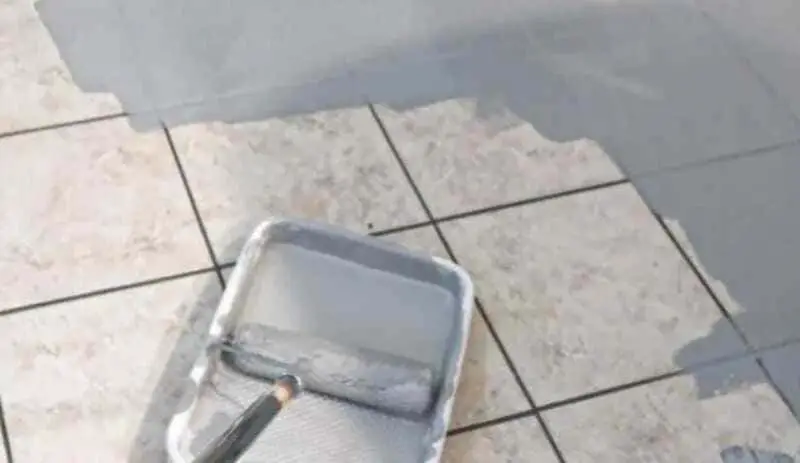Travertine is a highly valued material in construction and interior decoration, due to its natural beauty and durability. However, over time, travertine tile can lose its luster and appeal.
The good news is that painting can be an effective solution to renovate and give your travertine tiles a new look. In this article, we’ll explore the relevant topics on how to paint travertine tiles, from preparation to maintenance.

You’ll learn the materials and tools needed, application techniques, safety and environmental considerations, and tips for a flawless, long-lasting finish. With this guide, you will be able to give your travertine tiles a new look in a simple and effective way.
Travertine tile surface preparation.
Before starting inside how to paint travertine tiles, it is important to properly prepare the surface. This process includes cleaning and sanding the surface of the tile, which ensures that the paint adheres properly and looks even and durable.
It is also important to seal the pores of the travertine so that the paint does not penetrate them and make sure that the surface is completely dry before starting to paint.
It is important to take the time to properly prepare the surface before starting to paint, as this will ensure a satisfactory result.
Selection of painting materials and necessary tools.
Before starting with the process of how to paint travertine tiles, it is important to have the right materials and tools to achieve a satisfactory result.

The selection of paint materials is crucial, as some types of paint are not suitable for tile surfaces and may cause problems in the long run. It is recommended to use a special tile paint and a coat of sealer to improve the adhesion and durability of the paint.
In addition, it is important to have tools such as rollers, brushes and trays for paint application. With the right materials and tools, long-lasting and durable paint can be achieved on travertine tiles.
Cleaning and polishing process of the tiles before painting.
Before starting to paint travertine tiles, it is important to perform a thorough cleaning and polishing of the surface. This step is crucial to ensure that the paint adheres properly and lasts for an extended period of time.
Cleaning involves removing any dirt, dust or remnants of old materials, and can be done with warm water and mild soap. The tiles should then be carefully rinsed and dried.
Polishing, on the other hand, is a process that allows smoothing the surface and making it more uniform. This is achieved by using a sander or an electric polisher with abrasive discs. It is important to be careful during this process to avoid scratching or damaging the surface of the travertine.

After cleaning and polishing, the tiles are ready to be painted to enhance their appearance.
Choosing the right technique and type of paint for travertine tiles.
To develop the task of how to paint travertine tiles, it is important to choose the right technique and type of paint for the material. Travertine is a type of natural stone with unique pores and textures, so it is important to choose a paint that is compatible with the surface.
The painting technique is also important, as some techniques can leave marks on the porous surface of travertine. It is recommended to choose a technique that is smooth and uniform, such as roller or brush painting. In addition, it is important to choose a high quality paint that is resistant to moisture and fading.
Once the right type and technique of paint has been chosen, it is important to follow the manufacturer’s instructions carefully to achieve a professional, long-lasting result.
Application of the base coat and top coats of paint.
Before starting with the application of paint on travertine tiles, it is important to make sure that the surface is completely clean and dry. Once the surface has been properly prepared, you can begin applying the base coat of paint. It is important to choose a high quality paint suitable for ceramic surfaces to ensure a durable finish.
To apply the base coat, it is important to use a good quality brush or roller to ensure an even application and to avoid stains or marks. The base coat should be thin and uniform and the surface should be allowed to dry completely before applying the final coats of paint.

After the base coat is applied, the final coats of paint can be applied following the same instructions. It is important to allow each coat to dry completely before applying the next coat to ensure a uniform and durable finish. It may be necessary to apply more than one topcoat to achieve the desired finish.
Finally, it is important to allow the paint to dry completely before using the tiles or placing any objects on them. This drying process may take several days, but it is important to ensure a durable finish and prevent damage to the paint. By following these steps and using proper materials and techniques, a uniform and durable painted surface can be achieved on travertine tiles.
Safety and environmental considerations when painting travertine tiles.
Painting travertine tile is a project that requires care and caution, both for the painter’s health and the environment. When choosing the materials and tools needed for the task, it is important to consider the chemical ingredients that will be used and their potential impact on health and the environment.
Adequate ventilation is essential to avoid inhalation of toxic products, and it is advisable to use masks and gloves to protect the skin and eyes.
In addition, when choosing the technique and type of paint, it is important to ensure that it is resistant and durable, and that it does not contain environmentally harmful ingredients.
Overall, it is important to be aware of safety and environmental considerations when painting travertine tiles to ensure a successful and sustainable project.
Travertine tile paint maintenance and care.
Travertine tile paint maintenance and care is essential to preserve the beauty and durability of travertine tile over time. Regular cleaning with a mild detergent and water is sufficient to maintain the appearance and shine of the surface. However, it is important to avoid harsh chemicals, such as acids or abrasive products, as they can damage the surface and alter its color.
In addition, it is important to regularly seal the surface to protect it from absorbing liquids and to maintain its appearance. If there is any damage to the surface, such as scratches or stains, it is advisable to repair them immediately to prevent them from spreading and becoming more difficult to repair.
As for moisture protection, it is important to apply a water-resistant sealant to the surface to prevent moisture from penetrating into the cracks and damaging the paint. It is also advisable to avoid placing wet objects on the tile surface and to wipe up any spills immediately to avoid damage.
Overall, proper maintenance and care of travertine tile paint can prolong its lifespan and help maintain its beauty over time. With a little attention and regular care, you can enjoy the elegance and durability of these tiles for many years to come.
Final recommendations for a successful travertine tile painting experience.
Painting travertine tile can be an effective way to revamp the look of your home, but it’s important to follow a few final recommendations to ensure a satisfactory experience.
First, it is critical to choose a suitable travertine tile paint that is resistant to moisture and wear. This will ensure that the paint will last over time and will not flake or fade.
It is important to properly prepare the tile surface before you begin painting. This includes cleaning the surface with a mild detergent and drying it thoroughly before applying the paint. It is also advisable to lightly sand the surface to improve paint adhesion.
It is essential to follow the manufacturer’s instructions carefully, including the recommended number of coats and the drying time between each coat. This will ensure an even application and a smooth finish.
In general, it is important to take the time to properly prepare the surface and apply the paint carefully and evenly. By doing so, you will be able to enjoy a satisfying travertine tile painting experience and achieve an elegant, long-lasting finish.
